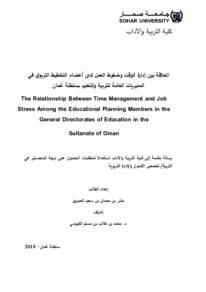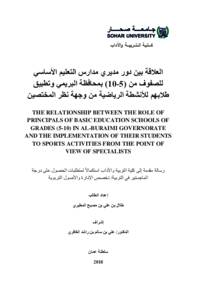Document
التخطیط لتطبیق بطاقة الأداء المتوازن لدعم الأداء الإداري بمدارس التعلیم ما بعد الأساسي في سلطنة عمان
Publisher
جامعة دمياط
Gregorian
2019
Language
Arabic
Subject
English abstract
Introduction
There is no doubt that education plays an important role in the development and development of society through the contribution of its institutions to the development of human resources and the continuous improvement in the level of performance of the educational institution and the performance of its employees it is necessary to improve the services provided by the post-primary educational institutions, And the level of its students, and thus affects the community's view of the educational institution and its graduates. Competitiveness in our time has become inevitable. It has bodies and departments which in turn possess policies, strategies and indicators. Their impact is clear on institutions that need growth. They also affect governments
that wish to raise their living standards and create a framework. Helps its institutions to acquire competitive capabilities that qualify them to compete with foreign institutions. In light of the increasing competition among the various educational, social and educational institutions, these institutions are required to adopt modern and effective managerial methods and tools that enable them to acquire competitive advantages and retain them for as long as possible and assist them in
selecting, implementing and evaluating their strategic plans. , Management processes, and various evaluation methods, including Balanced Scorecard. The last tool has seen a wide interest by researchers in the field of public administration, and has achieved its application in some different institutions Aha make a remarkable move from a mere tool of management tools into an
integrated system of strategic management.
Balanced Scorecard is an administrative system that translates the vision and mission of the organization into an effective tool that relates to and relates to the organization's strategy.
The use of the Balanced Scorecard enables the organization to evaluate performance in an integrated way by linking the multiple objectives that the organization seeks to achieve in order to strengthen its competitive position. The card translates the organization's vision and strategies into goals and standards that are classified in four dimensions To assess performance from a different perspective, performance is assessed from the perspective of shareholders, customers, internal operations, learning and growth. The present study considers that the Balanced Scorecard represents a modern intellectual and methodological approach in the field of organizational change and a supportive institutional framework for permanent innovation in modern organizations of all kinds. It is a balanced thinking approach and an operational tool that enables the institution to adopt its strategic objectives and assess its operational, financial and strategic performance in accordance with an integrated framework of financial and non-financial standards in a balanced manner to provide comprehensive information on its performance. And that the application of a card to measure the balanced performance on educational institutions works to consolidate the status of these institutions in the face of scientific progress in the present world. the study Problem:
Educational services are an intangible product that requires direct contact between the educational institution that provides the services and the beneficiaries in order to achieve full benefit, and the lack of interest in focusing on the satisfaction of the beneficiaries for the services provided to them affects the quality of services provided to these beneficiaries. Educational services are not available for storage and therefore cannot meet Needs to increase demand or
store excess thereof, so any shortage or increase affects performance appraisal. Traditional methods of evaluation have been subjected to many criticisms. These methods focus on results only without sufficient attention to the causes, which affects the supervisory role of performance measurement and evaluation systems. Traditional systems methods are historical systems that care about the past without the future and focus on measuring the results of performance In the
short term, although most administrative decisions have a long-term impact, some decisions only come to fruition not long after the decision is made. To achieve excellence and user satisfaction, the management leadership of educational institutions in post-primary education schools should be understood as imperative for change and the use of modern means and approaches to support performance in the educational institution. From the above, the problem of the current study was determined by the following main question: How can the Balanced Scorecard be planned to support administrative performance in post-primary schools in the Sultanate of Oman؟ The following questions arise from the main question:
1. What is the administrative performance of public and educational institutions (understanding, levels and entrances?
2. What is balanced measurement of institutional performance (concept - measurement models – difficulties)?
3. What is the reality of institutional performance in post-primary schools in the Sultanate of Oman?
4. What is a balanced performance card (concept - importance – dimensions)?
How well do they support the administrative performance of post-primary schools in the Sultanate of Oman?
5. What is the proposed model to support the administrative performance in post-primary schools in the Sultanate of Oman using a balanced performance card?
Objectives of the study:
The study aimed at:
The concept - measurement models - difficulties), as well as the
definition of the balanced performance card (concept - importance -
dimensions), and the extent of their contribution to support the administrative performance In the post-primary education schools in the Sultanate of Oman, to develop a proposed plan to support the administrative performance in postprimary schools in the Sultanate of Oman using a balanced performance card. the importance of studying:
The theoretical and practical importance of the study was determined as follows:
1. Educational institutions in the twenty-first century must work in the spirit and approach of business organizations. Performance support will contribute to linking performance management to the goals and strategies of the institution, but to the overall objectives of the government.
2. The importance of this study stems from the objective it seeks. Several studies of the Balanced Scorecard have been tested but have not been tested in practice on post-primary schools by combining theoretical framework with practical application. The importance of integrating frameworks for the development and follow-up of strategic plans, strengthening, and improving the decision-making process.
3. Provide responsible people with the essential knowledge and skills related to the most up-to-date strategic performance measurement tools in postprimary learning institutions, a Balanced Scorecard approach that helps these institutions measure their strategic performance to ensure full satisfaction of stakeholders in the learning process.
4. Preparation of a proposed model to support administrative performance
management tools have been unable to absorb the new variables that have characterized the educational institutions world, resulting in the fact that most of these tools have been unable to properly assess performance.
Study Approach:
The current study used the descriptive approach to its relevance to the nature of the study, as it is not limited to monitoring the data, but rather to search for accurate descriptions of the phenomenon to be studied and to analyze the internal environment of post-primary education institutions in Oman to identify their strengths and weaknesses and thus determine how to support balanced performance.
Study Tools:
Design of the Balanced Scorecard to support the administrative performance in the post-primary education schools in the Sultanate of Oman. The study was presented to a group of experts from university faculty members and their views on developing the card.
The limits of the study:
The current study limits are as follows:
Objectivity border:
The main pillars of performance support in post-primary schools in Oman include the contribution of the Balanced Scorecard to supporting performance in post-primary schools in Oman.
-Human frontiers:
The team consisted of a group of experts and members of the teaching staff of the universities and benefit from their views on the development of the Balanced Scorecard to support the administrative performance in post-primary schools in the Sultanate of Oman , which were designed within the proposed model.
-Spatial boundaries:
The research was conducted on the following governorates: North Batinah - South Batinah - Muscat - Interior - North East - Central - Dhofar - Musandam
Time limits:
Completion of the theoretical and field study 2016-2019. Study steps and stages:
In light of the problem of the study and to answer its questions, the chapters of the study are as follows:
1) Theoretical framework on literature: The conceptual frameworks of the administrative performance of public and educational institutions (concept, levels, entrances), balanced measurement of institutional performance (concept - models, difficulties), some Arab experiences in measuring balanced performance.
2) Proposed Model: To support the administrative performance of postprimary schools in the Sultanate of Oman using the Balanced Scorecard.
Results:
1) Balanced performance scorecard for the administrative performance in post-primary schools in the Sultanate of Oman. 2) Prepare a proposed model to support the administrative performance in post-primary schools in the Sultanate of Oman using a balanced performance card.
Study Recommendations:
1. Link the balanced performance measurement model to the reward and incentive system and the accounting system based on the extent to which employees achieve a competitive advantage.
2. The need for the attention of educational institutions to implement the Balanced Scorecard after restructuring the organizational culture to ensure the success of this entry.
3. Emphasize that the implementation of the Balanced Scorecard provides a clear and comprehensive picture of the University's performance by focusing on financial and non-financial standards.
Member of
Resource URL
Category
Theses and Dissertations







